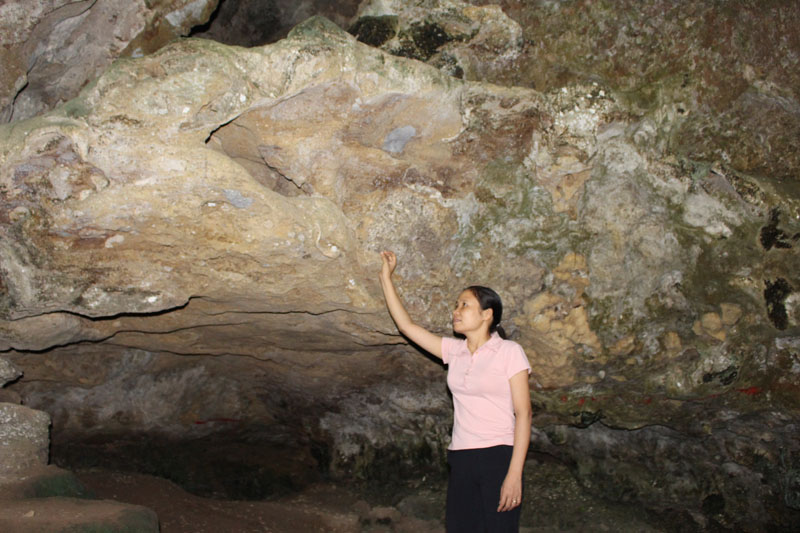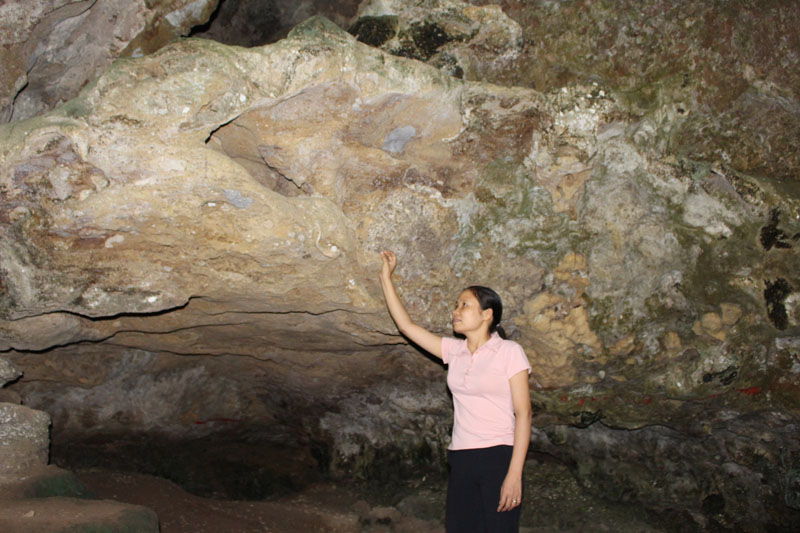
(HBO) – Cho Cave lies in the southwestern slope of Sang mountain in Hui hamlet, Cao Ram commune, Luong Son district – where a part of Hoa Binh culture inhabitants lived. In 1926, French archaeologist M.Coloni chose to unearth Cho cave relic site to study Hoa Binh culture.
Photo
caption: Residents in Cao Ram commune, Luong Son district explore Cho Cave
relic site.
Cho Cave lies in a favourable location with a wide valley having fertile
land and lush greenery all year round in front of its gate. Thanks to proximity
to water sources, it is easy to go hunting, picking fruits, seeking seafood and
herbs. For this reason, primitive inhabitants lived in Cho Cave, which was
evidenced by thick cultural layers containing molluscous feed wastes and big
sets of stone tools. With more than 1,000 artifacts on display at the Vietnam
Museum of History, the Anthropology Museum, the Vietnam Institute of
Archaeology and the Hoa Binh Museum, scientists affirmed that Cho cave is an
important archaeological relic site with great values for studies and
exploration of a famous prehistoric culture: Hoa Binh Culture.
Taking us to the unearthed areas in Cho cave, Dinh Thi Nu, a culture
official in Cao Ram commune said there are stone artifacts typical of Hoa Binh
culture such as pebble stone tools and others of oval, almond and rectangular
shape. Animal vestiges found in the cave showed that hunting was then a major
job. The main cultural layer is thick snail molluscous and clam shells. With
abundant vestiges and thorough preservation, one could imagine how the life in
the cave came along thousands years ago when holding left-over vestiges.
From such evidence, scientists believed that Cho cave dated back to 10,000
years ago and was in the period of transition to the New Stone Age.
With great values of Cho Cave, Chairman of the Cao Ram communal People’s
Committee Hoang Van Thuong said local residents are proud of Cho cave relic
site. The commune built a road leading to the cave with guards on standby. The
local people regularly come to clean up the road and grow trees in front of the
cave’s gate to attract tourists. However, the number of tourists to the site is
limited, mostly pupils in Luong Son district. Several foreign delegations came
for archeological work./.
The People’s Committee of Lac Son district held a ceremony on April 28 to receive the provincial relic certificate for the ancient rock carving site at Suoi Co stream, located in My Thanh commune.
A special music show titled "The country is in the fullness of joy” has been held at Hoa Binh Square in Hoa Binh city in celebration of the 50th anniversary of the liberation of the South and national reunification (April 30, 1975–2025).
The People's Committee of Lo Son commune, Tan Lac district, has organised the local annual traditional stream fishing festival on April 19 - 20.
As a land deeply intertwined with human history and Vietnam’s millennia-long journey of nation-building and defence, Hoa Binh is often revered for its epic tales and legends.
Residents of Hoa Binh boast a rich cultural identity, reflected in their unique language, traditional attire, customs, and folk melodies – described as "sweet as honey, clear as a mountain stream.”
Lac Son district’s Vu ban town held the 2025 Truong Kha temple festival on April 12–13 (the 15th–16th days of the third lunar month). Since its revival in 2019, the festival has been organised every three years, preserving valuable intangible heritage while meeting the community’s cultural and spiritual needs.



